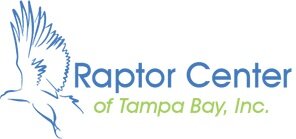
About RCTB
What We Do
To report a sick or injured bird, please call our hotline at 813-205-1851
The Raptor Center Policy
The Raptor Center of Tampa Bay rescues, raises, rehabilitates, and releases hundreds of wild, native birds of prey annually across the Hillsborough, Hardee, Highlands, Pasco, and Polk Counties of Florida. In addition, we provide transportation and facilitate solutions for non-bird of prey species; deploy rapid response teams to treat and transport to the best facility for the species; host environmental/nature education events for the general public, including children’s programs; and, work in conjunction with utility companies and other corporations to provide solutions for avian conflicts to reduce mortality.
RESCUE
Rescuing means finding wild birds that are sick, injured or orphaned, and are in need of a responsible human to help protect its survival.
REHABILITATION
Rehabilitating is not an easy task. Birds can’t tell us what is wrong. As we work to build our own facility our birds have to be transported to a variety of places for continued care.
RELEASE
We always try to return the birds to the general area where they were picked up. This gives the bird a better chance if survival since this is where nature intended it to be.
Our Rescue Policy
The main goal of our rescue efforts is to get the proper medical care and treatment needed for native Florida wild birds. With the help of good Samaritans who find birds and then find us, local law officials and our volunteers, The Raptor Center of Tampa Bay helps rescue over 600 birds annually.
Upon rescue each bird is given a full examination to best determine its best course of treatment. We work with a variety of veterinarians and partner rehabilitators in the area. We try to respond to most calls within an hour. We are 100% dependent on volunteers, we strive to respond quickly and professionally.
Our Rehabilitation Methodology
Our vets are not on site so the birds have to be transported to and from the vets. In many cases the best place for care can be well over 100 miles away from us. Support our cause to build the Raptor Center of Tampa Bay to rehabilitate our local birds, locally.
Make a donation to RCTB.
Please consider making a one time donation or recurring monthly donations today! We rescue over 1,000 wild birds and animals each year. We’re all in this together!
Birds Go Through 3 Stages of Rehabilitation
STAGE I - The Clinic or Hospital Stage
Birds are kept in crates in climate controlled environment often times in ICU units or on supportive heat. These birds are many times, hand fed and each day are cared for which may include administering medicine, tube feeding, giving fluids, changing bandages, doing physical therapy, etc.
STAGE II - The Rehabilitation Stage
Rehabilitation Outside takes place in rehabilitation mews. A mew is a wooden structure that is designed to house birds of prey or raptors. The birds begin to acclimate to being outdoors again by flying to perches for their physical therapy, and eating on their own. While there they continue to stretch their wings and exercise.
STAGE III - Flight
Just like a person who has been confined to a hospital bed and feels weak when they try to get up and move around, the birds’ chest muscles atrophy. It is necessary to Recondition for Flight within large flight enclosures before releasing back into the wild. Our center will have more than sufficient flight cages, allowing us to accommodate both the birds we rescue and the birds which are brought to our Center.
Flight
Factors We Take Into Account When Releasing A Bird
From the birds perspective, we make sure:
It is safe immediately around the release point
It is this familiar territory i.e.”home”
If it cannot be returned to its rescue point we determine if the habitat is suitable for the species and that there is prey readily accessible for it.
We always try to return the birds to the general area where they were picked up. This gives the bird a better chance if survival since this is where nature intended it to be. If it is returned home the food supply should be adequate unless the landscape has changed since rescue. Also all birds of prey mate for life. We want to return them to the area where they can find their partner.
Is the area free of potential hazards? We look at an analyze:
traffic
predators or mobbing birds such as crows
distance from the road
fences
livestock such as cattle
power lines in immediate release area
all bodies of water
Is the bird physically okay?
Birds can get injured in transport. It does not happen often but it can. We make sure no feathers or wings were damaged in the transport. We remove the bird from the container and give it a quick look over before we let it go. We check it’s legs to make sure any identifying bands or tie wraps were removed.
Is the habitat right?
Birds need to be in the right habitat. The majority of times we are returning birds of prey back to where they came from. If a bird has been shot, it will not be returned back to the same area. Although all shootings are reported to FWC rarely if ever is there enough evidence for an arrest or conviction.
Is it the right time of day?
Diurnal birds are released during daylight hours, preferably before noon, to give them plenty of time to get adjusted to their surroundings and find a place to roost.
Nocturnal birds, such as owls, are released after the sundown.
If all conditions are right we release the bird back into the wild where it belongs!







